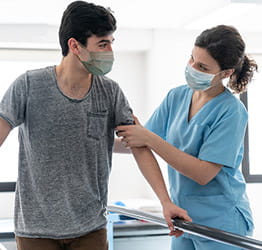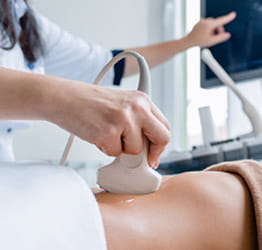
Above: The visual pathway
Visual electrophysiology is a tool for measuring and recording the tiny electrical signals our eyes send to our brains when we look at something. This testing can help diagnose the cause of vision problems in children who are too young to cooperate. It can also be used to monitor the development of a vision disorder or the effects of treatment.
Visual electrophysiology testing is noninvasive – meaning it happens on the outside of the body and doesn’t hurt.
What Is Visual Electrophysiology?
A visual electrophysiology study is recommended when a doctor wants to check how your child’s vision system processes visual information.
Visual electrophysiology measures and records the tiny electrical signals our eyes send to our brains when we look at something. These signals travel along our visual pathways to the part of our brains called the visual cortex.
The testing is noninvasive – meaning it’s on the outside of the body and doesn’t hurt.
What Procedures Do You Offer?
Visual electrophysiology testing ensures that your child’s retina, optic nerve, and visual cortex are working properly.
The Visual Electrophysiology Diagnostic Lab offers two important tests for children with vision issues: the electroretinogram (ERG), which monitors the function of the retina, and the visual evoked potentials (VEP) test, which monitors the function of the visual pathway from the optic nerve to the visual cortex.
Electroretinogram (ERG)
The ERG tests the function of your child’s retina. It measures the retina's response to flashes of light.
Test results from the ERG are useful in the diagnosis of several retinal diseases, including:
- Cone dystrophy.
- Cone-rod dystrophy.
- Congenital stationary night blindness.
- Drug toxicity.
- Leber congenital amaurosis.
- Retinitis pigmentosa.
- Retinal vascular disease.
Visual evoked potentials (VEP)
The visual evoked potentials (VEP) test is used to check if a child’s visual system has matured and how well it is working.
VEP can be used to determine the visual sharpness of infants and nonverbal adults by reading the eyes’ responses to flashes of light.
The two types of VEPs we measure are:
- Flash VEP — Determines visual potential and visual maturation.
- Pattern VEP — Detects lesions of the visual pathways.
Results from VEP testing can help evaluate children for neurological diseases, including:
- Amblyopia
- Cortical blindness
- Multiple sclerosis
- Optic neuritis
How Can I Prepare My Child for Visual Electrophysiology?
To best prepare your child for a visual electrophysiology procedure, explain it using the instructions below:
- On the day of your appointment, you will first check in with our main front desk and then head to the Owl Clinic.
- You will meet some of our team, who will explain the test and answer any questions you may have.
- Then, you will pick a movie or TV show to watch during the test. We have a list that can be provided while you are waiting.
- Enjoy your show while our team members put electrodes/wires on your head. (For our younger patients, we prefer to call them “ribbons.”)
- First, we will scrub the areas with a soap-like scrub and a cotton swab. The soap may feel sandy and a little cold.
- The electrodes will be placed on your head with paste. It may be a little sticky, but we will be sure to get it all off at the end of the appointment. This doesn’t hurt at all.
- Every now and again, the TV will turn off, and you will see some black and white squares. Look for the red dot and make sure it doesn’t move!
- This will be done a couple of times with different-sized squares.
- We may ask you to dress up as a pirate and wear an eye patch. Try to find that red dot with one eye at a time!
- After this, you will look at some flashing lights. They may be blue, red, or white! Sometimes, we put some stickers on your cheeks. We use a little bit of the same soap that we used for the electrodes when putting the stickers on your head.
- We may ask you to be a pirate and wear an eye patch again, but this time you will look at some more flashing lights.
- After that, your test is all done! We will help you get any sticky paste out of your hair with some warm water and cotton balls.
If you’d like more information about visual electrophysiology testing or to reschedule an appointment, call 412-692-3026 to speak with a staff member.
Frequently Asked Questions from Caregivers









